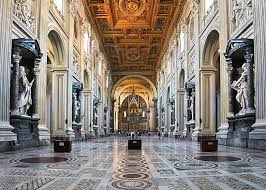Pretense:
- A false appearance or action intended to deceive.
- A professed but feigned reason or excuse; a pretext.
- Something imagined or pretended. (https://www.wordnik.com/words/pretense)
What term does one use for what happened at the cathedral of Saint John Lateran last week, on Tuesday, April 18th? A group of Anglican divines – not priests, still less bishops – said a service in the apse of the primary Church of Christendom, the Pope’s own cathedral.
…a group of about 50 priests, accompanied by their bishop, all belonging to the Anglican Communion, celebrated at the main altar of Rome’s cathedral, contravening canonical norms.
They prayed, we may presume, what they thought was a ‘Mass’ of sorts, which is ironic, as the forebears and founders of their religion, the Tudors, Henry and Elizabeth, Cranmer, Cromwell, the Seymours, and the rest of them, would stop at nothing to stamp out the ‘Holy Sacrifice’ – as well as the priesthood, while we’re at it. That was the point of the gibbet at Tyburn, the martyrs too numerous to be counted, the victims drowned in rivers of blood. Attending Mass, or even being in possession of a Roman Missal or a Rosary, was a capital offence, for which one would be hung, drawn and quartered.
Yet, here were their spiritual descendants, less anti-Catholic as the centuries have rolled on. Still, the sacramental ‘orders’ they presume to have were declared null and void by Pope Leo XIII’s 1896 Constitution, Apostolicae Curae.
When I teach my students about the sacraments working ex opere operato – from the ‘work being worked’, or from the very signifying act itself – I ask them what would happen if I were to say ‘Mass’, or try to – and they rightly answer ‘nothing’.
But not quite nothing, for it would be a gross irreverence, if not a sacrilege, especially if I were out to deceive people.
Now, the Anglicans were just being Anglicans, not pretending to be Catholics, and may not know any better, perhaps not cognizant of canonical norms – ignorantes sine culpa and all that. But the bishops and priests in charge of the cathedral should know, and they are now backtracking, citing a ‘miscommunication’ in allowing this:
A statement April 20 from the Lateran Chapter said Bishop Di Tora “expresses deep regret for what happened last Tuesday, April 18, inside the Basilica of St. John in Rome.
The initial justification was a spirit of ecumenical ‘reciprocity’, even though the be-robed ministers could easily have held their service in any one of the Anglican ecclesial buildings in Rome, where they wouldn’t have twelve oversized statues of the Apostles staring down at them.
Another irony, pointed out by many, is that someone in some sort of authority must have given permission for 50 Anglican divines to pretend to say Mass in the main church of the Church, but just try getting permission to say a TLM anywhere near there. As Liam Neeson might put it, ‘good luck’.
Benedictine Father Martin Browne, an official at the Dicastery for Promoting Christian Unity, admitted it would have been more appropriate if this dicastery and other relevant entities of the Holy See had been involved in considering the request.
Indeed. We may hope that sanity still resides somewhere in Rome, that this debacle was unintended by the highers-up, and doesn’t happen again. But one does wonder…’Tis easier to ask forgiveness than permission, and a misdeed done is easier to do once, twice, three times more.
The Church used to be stricter about ecumenical endeavours, as one may gather from a brief perusal of Pius XI’s 1928 encyclical Mortalium Annos, when Catholics were scarcely ever allowed even to enter a Protestant building, never mind be present at their services. Perhaps it’s time to revisit some of those principles and practices, which were not uncharitable, but rather spoke to a deeper charity: Maintaining the distinctions between true and false worship – and consequent teaching – allows those outside the Church founded by Christ more easily to see and accept the fullness of truth, clearly and without compromise.

